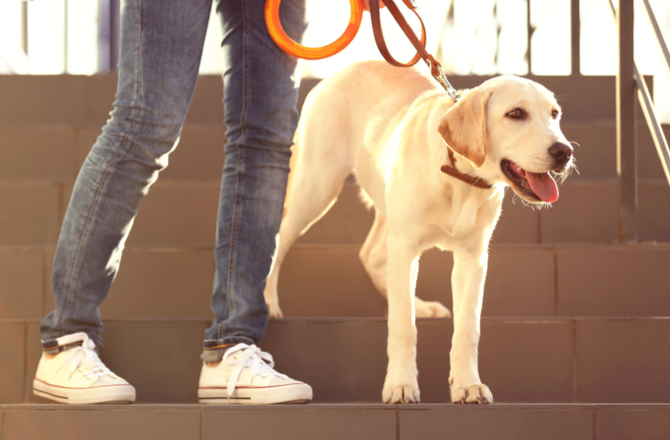
All responsible dog owners should know about proper dog joint care. Some pet owners think that dog joint care is only for senior dogs. This is actually not true. It’s never too early to start prevention measures on your young dogs. You also need to pay particular attention if you have big dogs. Large dogs in particular are prone to joint problems later in life.
Have you ever caught your dog moving stiffly at times? How about your pet struggling to lie down or get up?
Below is a comprehensive list of the symptoms our pets display when they are having joint problems:
Symptoms of Dog Joint Problems:
– Difficulty getting up and lying down, climbing stairs
– Stiff movements
– Decreased physical activity
– Limping
– Aggression or withdrawal
– Joint swelling
– Panting excessively
– Favouring a limb or holding it off the ground
If you notice your pet doing any of the above, they may be suffering from joint problems. There are different causes for dog joint problems. Below is a list of the most common causes.
Most Common Causes of Dog Joint Problems:

1. Osteoarthritis
Osteoarthritis is the most common joint disease for aging dogs. It stems from years of wear and tear on the joints, and has very few symptoms in its early stages. Take your dog for regular checkups so your family vet can catch it early.
2. Hip dysplasia
Hip dysplasiac is a condition where the hip doesn’t fit properly in its socket.
Young dogs with this condition are advised to fully mature first before surgery is considered. Surgery does not actually remove the issue but will instead merely shift the weight-bearing surface of the ball joint, creating relief in older dogs but doing nothing for younger ones.
With proper dog joint care, canines suffering from hip dysplasia can still live full lives and even participate in dog shows as they reach maturity.
3. Chronic dislocating patella

Chronic dislocating patella refers to a dislocated kneecap. It is usually caused by trauma or genetic malformation and will normally start showing around four months after birth.
Most dogs suffering from chronic dislocating patella will hold their hind legs up for a few minutes. This is because when the kneecap slips from the groove of the thigh bone, it can only be returned to normal once the quadricep muscles in the dog’s hind legs relax and lengthen.
Unsurprisingly, a slipped knee cap is common in small and miniature breeds like the Yorkshire Terrier, Pomeranian, Pekingese, Chihuahua, and Boston Terrier. We’d tell you to stay away from toy breeds because of genetic malformations but if you’re already in love with your petite pet, proper joint care might be a better option for you.
4. Obesity
Large dogs are not spared joint problems. Obesity, especially in large dogs, cause heavy wear and tear on the joints that lead to difficulties when they are older.
This is just one more reason to exercise your dog and keep his food intake at healthy levels.
5. Torn ligaments
Torn ligaments or injuries from falls may also cause issues later on. If your dog suffered physical injuries from a fall, make sure they heal properly and take your dog to a vet for a check-up.
Now that we know the common causes of dog joint problems, how about the treatment and care?
Treatment of Dog Joint Problems:
Depending on the joint problems your dog has, your vet may opt for any of the following treatments.
1. Omega-3 fatty acids
Omega-3 fatty acids have anti-inflammatory effects, and the best supplements nourish and repair joints. Vetz Petz Antinol, for instance, has been clinically proven to be effective in dog joint care.
2. Anti-inflammatory drugs
Anti-inflammatory drugs come in two kinds – steroidal and non-steroidal.
Both non-steroidal and steroidal anti-inflammatory drugs can have several side effects, so it is recommended that blood serum chemistry be performed beforehand. It will check for any other preexisting ailments your dog has that may be made worse by the drugs.
3. Therapy lasers
Therapy lasers work to heal injuries and manage pain. When this therapy is used on dogs, it increases the release of endorphins, which are natural painkillers. They also help lower inflammation, restores metabolic function and improve healing rates.
If you’re worried if this is safe on dogs, this therapeutic procedure has been in use on humans before it was tried on our canine pets.
4. Narcotics
Narcotics are usually a veterinarian’s last resort if the other options aren’t working for your dog’s joint pain.
Prevention of Dog Joint Problems:
Treating and managing dog joint problems in our dogs can be costly and time-consuming. The old axiom about an ounce of prevention is worth a pound of cure.
Below is a list of effective techniques so pet owners can avoid dog joint problems.
1. Avoid excessive wear and tear on the joints.
Don’t let your dog run too hard or jump too high, particularly when he’s a puppy as his bones and joints aren’t fully developed yet. Place a footstool for your dog to use when getting into the car so he doesn’t have so far to jump.
2. Feed your dog glucosamine and chondroitin supplements when young.
These help care for your dog’s joints.
3. Research and invest in good dog food for your pets.
There are dog foods made especially for dog joint care purposes. Invest in these when your dog is young, and keep it up.
4. Maintain your dog’s healthy weight.
Watch your dog’s weight. Obesity strains the joints, especially in large breeds.
Exercises for Dog Joint Care:
Whether you’re trying to prevent dog joint problems or treat them, these exercises will be helpful for your dog.
– Swimming is a highly-recommended and excellent exercise for dogs with joint problems, because it takes the weight off their painful joints while still allowing them to engage in low-impact physical activity. Do note that older dogs are very sensitive to heat and cold, so make sure there isn’t too great a temperature difference and allow them to ease into it slowly.
– Walking is another low-impact exercise for your dog. Walk him for 10-15 minutes at a slow pace.
– Gentle play with your dog, such as fetch (don’t throw it too far), is also good exercise for him, and will be fun for you both.
– Massaging your dog reduces his muscle tension, removes lactic acid, and increases the absorption of nutrients in his muscles. It allows him to recover from fatigue faster and perform better. Your pal will also love the extra attention!
– Gentle stretching gives your dog greater flexibility, giving him good mobility around the joints and easing the pressure on them. This makes him more resistant to joint injuries in falling mishaps. Lay your dog down on his side and lightly stretch his limbs at the joints, as well as his paws and toes.
And finally, don’t forget that apart from proper dog joint care treatments, you also need to keep your dog comfortable as he ages. Older dogs need a greater buffer against heat and cold, so a warm bed in winter and a cool bed in summer will do wonders for your pal’s aching joints.
A mobility harness or a ramp will also take some of the pressure off your dog’s joints when he struggles to climb to higher areas, such as the car, the couch, or up to the second floor.
Our pets give us much unconditional love 24/7. In turn, one of the ways to return this affection is to make sure they are pain-free and enjoying good joint care from us.

0 Comments